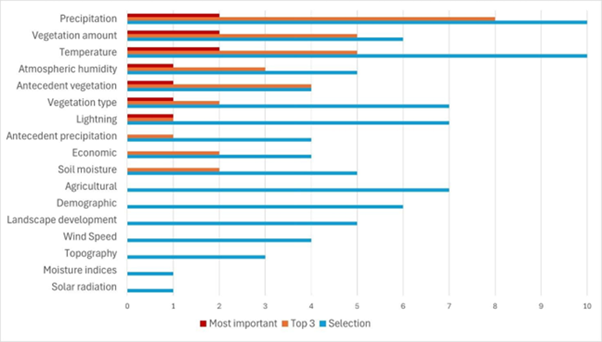The Leverhulme Wildfires Fire-Veg Giraffe Team has published a new paper “The Global Drivers of Wildfire” in Frontiers in Environmental Science. This paper compares how the processes embedded in the current global empirical fire models relate to findings of recent empirical analysis on the controls of burnt area globally and what the implications are for the modelling community. The paper calls for a rethink on the assumptions that are built into our current models.
Current global empirical fire models diverge in their assumptions
Three empirically based fire models that are represented in the Fire Modelling Intercomparison Project, GLOBFIRM (Thonicke et al., 2001; Kloster et al., 2010), SIMFIRE-BLAZE (Knorr et al., 2014) and INFERNO (Mangeon et al., 2016). These three models diverge in the processes they represent. Whilst fire occurrence is determined by ignitions in INFERNO, in GLOBFIRM and SIMFIRE-BLAZE, ignitions are not limiting, and fire occurrence is only determined by the conditions of fuel load and climate. All three models use plant functional types (PFTs) to determine landscape flammability, however their representations of fire size differ. Whilst INFERNO prescribes a fire size for each PFT, fire size is dependent on the fire season and the number of days with a probability of burning greater than one for SIMFIRE-BLAZE and GLOBFIRM respectively. These differences in the processes considered and in the final simulation of burnt area between the models highlights the uncertainties our understanding of the empirical controls on fire.
Exploring the literature
The paper identified empirical analyses that 1) fitted statistical models to a set of variables to explore the controls of burnt area and 2) explicitly ranked the importance of these different variables. Although the initial selection of the variables reflects the underlying assumptions of each research group on the mechanisms that control burnt area, the relative importance of these variables did not always reflect the frequency with which they are included in analyses.
- Atmospheric humidity consistently shown to be an important variable
Atmospheric humidity was included in analyses only half as frequently as temperature and precipitation, it emerged as one of the most important controls. Atmospheric humidity is a strong control on both live and dead fuel moisture, which explains this finding. In a modelling context, fuel moisture is more often represented by soil moisture (only indirectly related to humidity) or some kind of moisture index – both of which are shown to be relatively unimportant in these empirical analyses.
- Fuel availability was more important than fuel type
Variables relating to fuel availability were included as often as variables relating to fuel type, when considering antecedent conditions, vegetation amount emerges as the single most important control on burnt area, being the most important predictor in a third of the studies.
- Ignitions and fire spread do not emerge as key
Variables relating to ignitions, fragmentation and fire spread were often included, but did not emerge as important in many of the studies.

Figure 1. Summary of variables selected and considered important for predictions of burnt area in global empirical analyses. The individual bars show the number of studies which included the variable as a predictor (blue), the number of times the variable was selected as the most important driver of burnt area (red) and the number of times the variable was in the top three predictors (pink).
Lessons for Fire Science and Modelling
The patterns that emerge from the literature offer several key lessons to the modelling community:
- Focus on variables directly related to fuel load and drying
Models should focus on the processes most closely related to fuel load and drying. Instead of metrics of soil moisture, a focus on the effect of atmospheric humidity is needed. Furthermore, a shift towards measures of vegetation amount as opposed to vegetation type (PFT) will improve model performance. - Rethink our assumptions on ignitions, fragmentation and fire spread:
The study shows that there is a need to rethink our assumptions on ignitions, fragmentation and fire spread. The effect of these drivers on burnt area are complex and require more exploration.
This research was a collaboration between our centre and the LEMONTREE project (Lemontree – Land Ecosystem Models based On New Theory, obseRvations and ExperimEnts (reading.ac.uk). You can read the full paper here:
Haas, O, Keeping, T., Gomez-Dans, J., Prentice, I.C. & Harrison, S.P. 2024 The global drivers of wildfire. Frontiers in Environmental Science. 12, doi.org/10.3389/fenvs.2024.1438262
 Dr Olivia Haas is a postdoctoral research based at the University of Reading, focused on modelling fire-vegetation interactions.
Dr Olivia Haas is a postdoctoral research based at the University of Reading, focused on modelling fire-vegetation interactions.
Feature Image: Prescribed fire at the Fire Adapt Brazil Study Hub, 2024, by Adriana Ford






